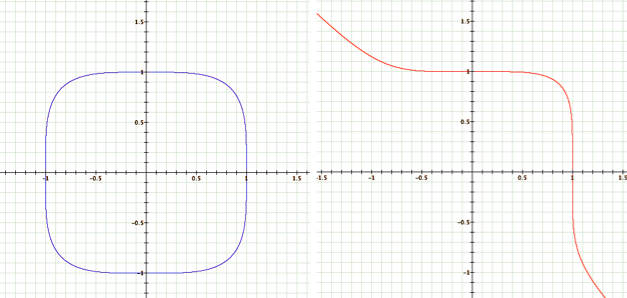
Exploring
xn +yn = 1
by Molly McKee
Examine the following graphs:
x2+y2=1, x3+y3=1, x4+y4=1, x5+y5=1
Based on what you found, what do you expect for the graphs of:
x24+y24=1 and x25+y25=1

On the left is the graph of x2+y2=1 and on the right is the graph of x3+y3=1.
Lets call these Graphs A and B, respectively.
Notice that Graph A is a circle. We can see that this is a true representation of the equation by checking some of the points: x2=1-y2
By rewriting the equation in this way, we see that when x=0, y=1 or y=-1 and when x=1 or x=-1, y=0. But what happens if you choose a value for x which is larger than 1? Try the value x=2. We know that x2=22=(2)(2)=4, but how can 1-y2=4? This could only be possible if y2=-3. However, since a number raised to an even power (for example 2, 4, 6,...) can never be negative, we know that our Graph A is restricted to the values -1≤x≤1 and -1≤y≤1.
Notice that Graph B, although it is a similar equation, does not create a closed shape. This graph is closer to a line with a rounded portion. Before examining Graph B in depth, let’s compare the two equations and see what their similarities and differences are. Recall the first equation, x2+y2=1, and now look at the second equation, x3+y3=1.
What do the two equations have in common?
-
‣Both equations are equal to 1
-
‣Both equations are the sum of two variables which have been raised to the same power
How are the two equations different?
-
‣One equation raises its variables to an even power and the other equation raises its variables to an odd power
We can see now that the most outstanding difference between these two equations is the value of the exponent. Let’s examine what happens when a number is cubed (or raised to an odd power such as 3, 5, 7,...). Let x=2, then x3=23=(2)(2)(2)=8. Now let x=-2. Recall that if a negative number is squared the result will always be a positive number: (-2)2=(-2)(-2)=4. However, (-2)3=(-2)(-2)(-2)=-8. This means that Graph B will not be restricted like Graph A was. Let’s check some of the points of Graph B: x3=1-y3. We immediately can see a difference from the first equation: When x=0, y=1 and when x=1, y=0, however when x=-1, y3=2 and when y=-1, x3=2. Unlike in the first equation, it is possible to find a number whose cube is 2 or -2. Therefore Graph B is not restricted like Graph A.
Now let’s examine two more equations: x4+y4=1 and x5+y5=1; we will call them Graphs C and D, respectively.
Graph A
Graph B

Graph C
Graph D
Notice that Graph C is similar to Graph A; both represent a closed shape whose points appear to be restricted between -1 and 1. Also, Graph D is similar to Graph B; both are lines containing a rounded portion. Also notice that the rounded parts of Graphs C and D are less subdued than in Graphs A and B; theses areas on Graphs C and D are slower becoming more like corners or points. Where Graph A was obviously a circle, Graph C looks more like a rounded square and where Graph B is more of a slope, Graph D is more of a ledge.
The following graph shows differences and similarities of Graphs A-D; Graphs A and B are blue and Graphs C and B are red:

Based on the similarities and differences of Graphs A-D, as well as their corresponding equations, it is possible to hypothesize the following about the graphs of x24+y24=1 and x25+y25=1:
x24+y24=1
-
‣First notice that since 24 is an even number, what we discovered about even exponents in Graph A should still hold true. Therefore the graph of x24+y24=1 should be a closed shape which is restricted to the values -1≤x≤1 and -1≤y≤1. Although its graph will be similar to Graphs A and C, the ‘corners’ of the shape will be more pronounced, as if it is forever approaching (but will never reach) a square shape.
x25+y25=1
-
‣First notice that since 25 is an odd number, what we discovered about odd exponents in Graph B should still hold true. Therefore the graph of x25+y25=1 should be a line with a curved portion. Although its graph will be similar to Graphs B and D, the ‘curved portion’ of the line will become more angular, as if it forever approaching (but will never reach) a squared off corner or ledge.






